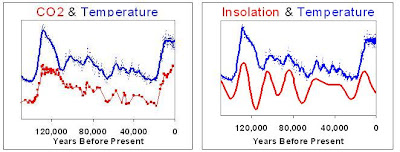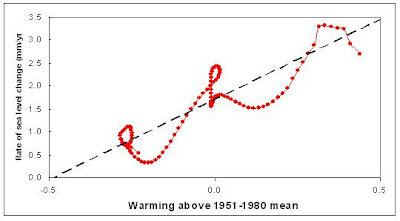Return to Topics page.
Return to Criticisms of Al Gore's "An Inconvenient Truth"
Gore shows a series of four images of Lake Chad on page 116 of his book. The pictures show the lake shrinking from about 25,000 square kilometers in 1963 to about 1,500 square kilometers in 2001. Very dramatic indeed, this drought was abrupt and catastrophic for the people in this region south of the Sahara desert. Gore implies the following sequence of events: Anthropogenic CO2 causes Lake Chad to dry up, then the stresses caused by this depleted resource cause, or exacerbate, regional violence, famine and genocide.
Gore is wrong for two reasons
1. Lake Chad was shrinking long before anthropogenic increases of CO2. It is known that Lake Chad was vastly bigger several thousand years ago than it was in 1963, when Al Gore starts his tale about the lake’s demise. Paleological evidence makes it clear that abrupt changes have been common and the lake has shrunk to its current size or smaller multiple times in the last thousand years.
2. The current low level of Lake Chad is due, at least in part, to greater demands on the water of the in-flowing rivers. The population of the region has more than doubled since the most recent drought began and a large fraction of the water that would normally flow into the lake is being dammed and diverted for irrigation long before it reaches the lake.
Lake Chad was already shrinking
While he is almost certainly right about water shortages aggravating social problems, he is certainly wrong about anthropogenic CO2 being the cause. His aim goes wildly off the mark when he makes an important, but wrong, point on the page 117 where he says "When it was full, Lake Chad was the sixth largest lake in the world…” This gives the impression that prior to 1963, “when it was full,” the Eden that was Lake Chad had existed in a 25,000 square kilometer steady state perpetually from the deep past.
The truth is that Lake Chad has undergone extraordinary changes in the relatively recent past. The Lake Chad of 1963 was just a tiny remnant of what is known to paleontologists as “Lake Megachad.” Just a relatively short six to seven thousand years ago, when Badarian culture was populating upper Egypt and the Yangshao and Longshan cultures of prehistoric China were cultivating grains, domesticating animals and making villages, Lake Megachad was the biggest lake in the world! It was 400,000 square kilometers – five times bigger than Lake Superior is today! 7000 years ago its surface area was 16 times bigger than it was in 1963, and its volume was dozens of times greater. In the Journal The Holocene, Drake and Bristow (2006) point out that Lake Megachad may have been as large as 800,000 square kilometers further back in time.
According to Section 3.1 of the United Nations Environmental Programme (UNEP) report, Africa’s Lakes – Atlas of Our Changing Environment, Lake Chad “levels regressed until, between 5,000 and 2,500 years ago, the lake assumed its current level with periodic oscillations. By 1908 the lake levels were so low that the lake resembled a vast swamp with small northern and southern pools. During the 1950s, levels again increased, joining the southern and northern pools, so by 1963 the lake covered 22,902 km2 (8,842 square miles).” Note that 1963 is the year the Gore conveniently starts his tale about Lake Chad. Somehow he forgets to tell his readers and viewers that 1963 Lake Chad was at its highest level for the entire 20th century. (See figure 1.) In fact, the lake size increased dramatically during the 50 years previous to 1963. Gore’s narrative would not be quite so compelling if he had started it in 1908, because by 2001 the lake level was almost the same as it was back in 1908.
Butzer (1983) did a comprehensive paleo-environmental review of Lake Chad and the entire Sahel to put the recent drought into historical perspective. He took into account stream deposits, fossil sands, lake beds, abandoned shorelines, paleosols, fossil pollen and lake microorganisms. He says the primary record has been “well fixed in temporal terms by an unusually large number of radiocarbon dates.” The paper gives numerous examples of rapid rises and falls for Lake Chad over the last 20,000 years. Comparison of the Lake Chad data to data from the rest of the Sahel “shows that the history of Lake Chad is fully representative of hydrological changes across the Sahel.” He concludes with “The lake records discussed here are among the most detailed available for the Late Quaternary of Africa.” He points out that droughts like the most recent one “are verified on at least 6 occasions since 1400 AD, and may have a recurrence frequency of three times per century.” This drought, he says, “falls well within the range of short and medium variability directly documented for the last few centuries and indirectly shown for the last 12 millenia.”
Figure 1. 130 year history of Lake Chad elevation. Note that the 20th century maximum occurred in 1963. The rapid elevation drop at the end of the 19th century occur ed before significant increased in anthropogenic CO2. The most recent elevation data has the lake level almost as high as it was 100 years previous. Double click the image to see a larger version.
And there’s more. There were other megalakes that existed in the Sahara. Lake Megafezzan was north of Lake Megachad in present day Libya, the Chotts Megalake was in present day northern Algeria and the Ahnot-Moyer Megalake in central Algeria. Figure 2 shows a map of North Africa with the now missing megalakes. The inset of the North American Great Lakes (from Google Earth) is at the same scale and is included for comparison purposes. These lakes did not dry up millions of years ago. They still existed as bodies of fresh water during in the mid-holocene just thousands of years ago, when human beings had already spread over the entire globe. It clearly was not anthropogenic CO2 that caused the mega-lakes to dry up or Lake Chad to shrink and oscillate so widely in the previous several millenia. How can “An Inconvenient Truth” make the claim that anthropogenic CO2 is responsible for Lake Chad’s recent shrinking and oscillations when this is a continuation of a long existing pattern.
Figure 2. The Megalakes of the Sahara region. These gigantic lakes have disappeared in recent millenia. Lake Chad is the only remaining trace of water from these giants. The inset shows the North American Great Lakes at the same scale (from Google Earth) for comparison purposes. The megalake size and shape data is from the Megalakes Project. Double click on the image to see a larger version.
Figure 3. The site of Lake Megafezzan as it appears today. All that remains is sand. (Image from Google Earth)
Larger and larger fractions of the in-flowing water is being diverted before it reaches the lake.
A major contributing factor to Lake Chad’s reduced size in the 21st century is the human manipulation of the water system through damming and irrigation. Multiple dams and irrigation systems have been built upstream on the rivers that feed the lake. The Global International Waters Assessment (GIWA) report by the University of Kalamar on behalf of the United Nations Environmental Programme states that
“The GIWA Assessment considered anthropogenic stream flow modification as having a severe impact on freshwater availability. Although the Lake has already dried out several times in the past and therefore recent shrinkage is not a new phenomenon, the trend has been severely exacerbated by human stream flow modification….In areas of the Lake Chad Basin, despite the relative abundance of water at times, the flow of rivers has been constantly diminishing (Nami 2002) partly due to decreasing rainfall in the hydrologically active upstream basins but also as a consequence of the increased abstraction for human consumption. This abstraction has dramatically modified stream flow through the construction of dams upstream of the catchment, that have not taken sufficient account of the people and ecosystems downstream of the development.”
A profound example of the impact of human diversion of water from Lake Chad is illustrated in the (UNEP) report mentioned above, where it is pointed out that “Since the 1960’s human demands for water near Lake Chad have grown rapidly. Between 1960 and 1990, the number of people living in the lake’s catchment area has doubled from 13 million to 26 million.” This growing need for water has resulted in huge irrigation projects and dams along the rivers that feed Lake Chad. Of the Komadougou-Yube river system the report states “The upper basin used to contribute approximately 7 km3/yr to Lake Chad. Today, the bulk of this water is impounded in reservoirs within Kano province in northern Nigeria, and the system provides just 0.45 km3/yr.” By my calculations that is enough impounded water each year to double the current volume of the Lake.
The greatest inflow to Lake Chad comes from the south via the Chari-Logone River. However, since the 1970s the Chari-Logone stream flow has been drastically modified. The construction of the 30 kilometer wide Maga Dam for the creation of Maga Lake, and 80 kilometers of dykes along the Lagone downstream from the dam have had a profound impact in Lake Chad. This construction was part of the well intentioned SEMRY irrigation project to open up more agricultural land (mostly rice) and fish farming. According to GIWA, "This diversion of water from the Chari River for agricultural purposes has contributed to the decreasing stream flows and the discharges into, and extent of, the Lake Chad....According to expert opinion the most significant GIWA assessed immediate cause [for low stream flow into Lake Chad] is the increased diversion of rivers and the associated unsustainable use of water resources."
Return to Topics page.
Return to Criticisms of Al Gore's "An Inconvenient Truth"
References
Drake and Bristow, Shorelines in the Sahara: geomorphological evidence for an enhanced monsoon from palaeolake Megachad, The Holocene, Vol. 16, No. 6, 901-911 (2006)
DOI: 10.1191/0959683606hol981rr. Get copy here
United Nations Environmental Programme (UNEP) report, Africa’s Lakes – Atlas of Our Changing Environment, section 3.1 Get copy here
Butzer, K.W., Paleo-Environmental Perspectives on the Sahel drought of 68-73, GeoJournal 7.4, 369-374 (1983) Get copy here
Global International Water Assessement (GIWA) , Lake Chad Basin – GIWA Regional assessment 43 - assessment, Get copy here
Return to Topics page.
Return to Criticisms of Al Gore's "An Inconvenient Truth"





























